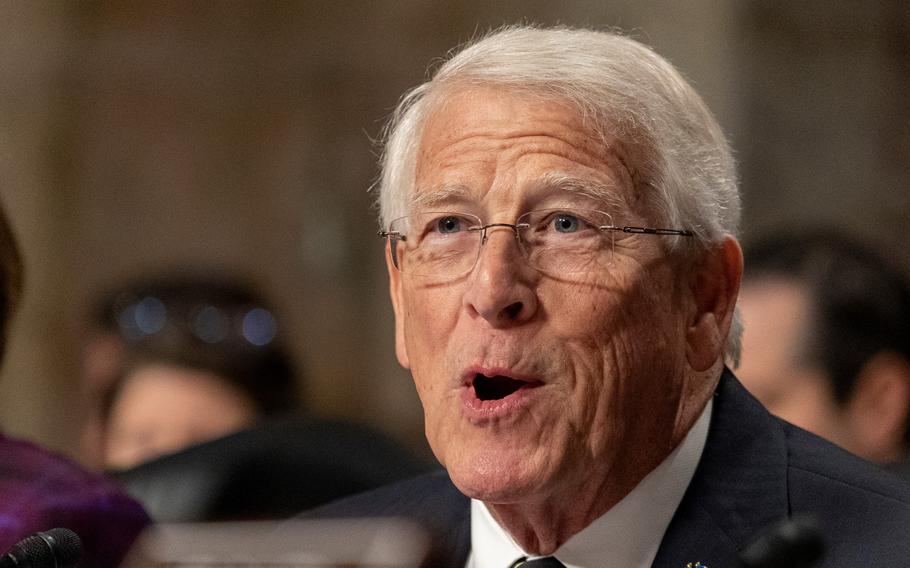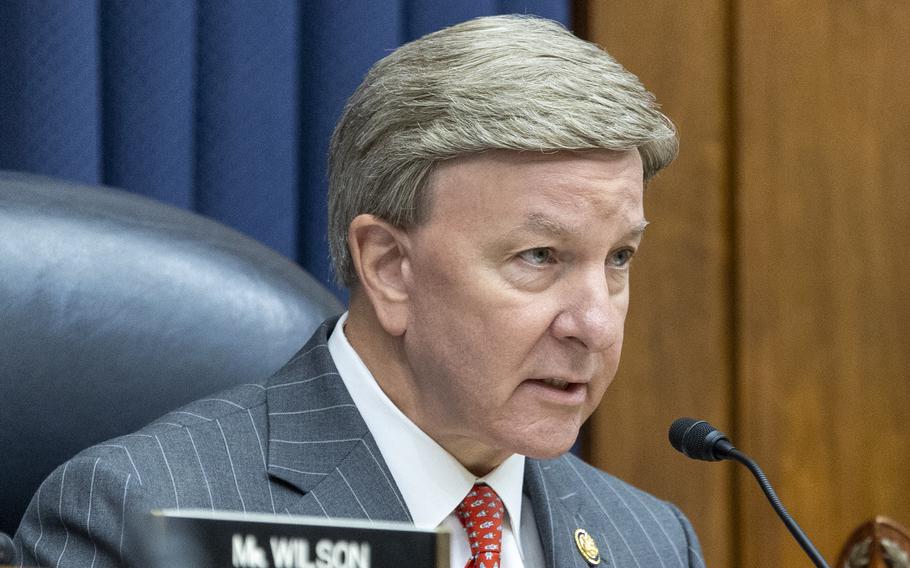
Sen. Roger Wicker, R-Miss., chairman of the Senate Armed Services Committee, speaking Jan. 14, 2025, during a hearing. (Eric Kayne/Stars and Stripes)
WASHINGTON — The Senate’s version of a sweeping bill to advance President Donald Trump’s domestic agenda includes about $150 billion for defense, deviating slightly from the House’s legislation with extra boosts for munitions and technology and less for shipbuilding.
The defense portion of the bill, released late Tuesday, is about the same amount as the $150 billion allocated for the military in a measure that the House passed last month but makes several changes to funding amounts for individual priorities.
It otherwise shares the same broad defense spending goals as Republicans try to adopt Trump’s massive policy and tax-cutting legislation through a process called reconciliation, which bypasses Democrat opposition.
“This is a wonderful opportunity to jumpstart getting back where we need to be in national defense,” Sen. Roger Wicker of Mississippi, the Republican chairman of the Senate Armed Services Committee, said Wednesday at a Defense Writers Group event.
The Senate is expected to vote on its version of the reconciliation measure in the coming weeks, with a goal of sending the final legislation to Trump by July 4.
Wicker noted while Democrats will vote against the overall legislation, many will be supportive of the spending increase on defense.
“I really think maybe 85 senators, if you ask them, ‘Do they want this $150 billion to be enacted?’ They would say yes — Democrats and Republicans,” he said. “We’re united on that and we’re ready to go, it’s the other parts that will take some massaging.”
The senator has been a vocal proponent of pushing the Defense Department’s budget higher to meet threats from China, Russia and other adversaries. He wants defense spending to reach 5% of gross domestic product from its current 3% and said the reconciliation bill is a “major opportunity” to catch up to that goal.
The Senate’s legislation matches the House in authorizing $25 billion for the Golden Dome missile defense system, $12 billion for U.S. Indo-Pacific Command and $9 billion for improving quality-of-life issues for service members.
But it deviates from the House’s approved figures in other priorities.
It adds $2.6 billion to the House’s $20.4 billion authorization for munitions production, increases efforts to bolster readiness by $4.5 billion on top of the $11.5 billion approved by the House and bumps up production of new technology such as drones by $2.5 billion from $13.5 billion.
Spending on aircraft procurement is increased by $1.8 billion under the Senate plan while spending on shipbuilding, a priority for Trump, is decreased from the $33.7 billion authorized by the House to $28 billion.
The bill also includes $1.7 billion less in funding for the military’s mission on the U.S.-Mexico border, for a total of $3.3 billion.
Wicker said Wednesday that he and Rep. Mike Rogers of Alabama, the Republican chairman of the House Armed Services Committee, were in “very close” alignment on spending priorities, alongside the White House.
“We are largely of one mind on this,” he said. “We may have had to do an adjustment or two, but we’ve done it in coordination with the administration and the House.”

Rep. Mike Rogers, R-Ala., chairman of the House Armed Services Committee, speaks Wednesday, June 4, 2025, during a hearing about the Army budget. (Eric Kayne/Stars and Stripes)
Rogers, in a statement, said he and Wicker worked closely together to identify “how we can best modernize our military, regrow our defense industrial base and build a ready, capable and lethal fighting force.”
The defense money authorized in the bill is required to be spent by the end of the 2034 fiscal year. The Senate is proposing $10 million for the Pentagon to conduct oversight of the new funding.
Wicker, while praising the legislation, said it was still not a replacement for meaningfully increasing the Pentagon’s budget every year.
He bristled at the White House’s proposal to keep military spending flat for fiscal 2026 and said he viewed attempts by some in the administration to count the reconciliation bill as part of the Pentagon’s budget as a “sleight of hand.”
“We need a steady increase in terms of the baseline year after year after year to get to where we need to get,” Wicker said. “We cannot be asking our allies to go from their anemic 2% or less of GDP to 5% if we’re not willing to do that ourselves.”